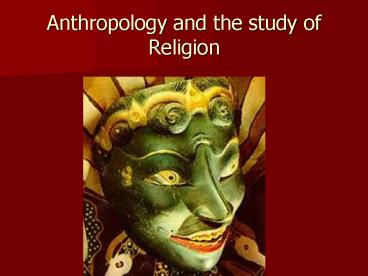Anthropology and the study of Religion - PowerPoint PPT Presentation
1 / 21
Title:
Anthropology and the study of Religion
Description:
... Levi-Strauss and structuralism Claude Levi-Strauss and Myth Anthropology is also interested in religious and quasi-religious stories about supernatural ... – PowerPoint PPT presentation
Number of Views:606
Avg rating:3.0/5.0
Title: Anthropology and the study of Religion
1
Anthropology and the study of Religion
2
Sir Edward Burnett Tylor/ANIMISM
- Tylor was a founder of the anthropology of
religion - Tylor thought, religion was born as a people
tried to understand conditions and events they
could not explain
3
Tylor(cont)
- Tylor believed that our ancestors were
particularly intrigued with death, dreaming and
trance - Tylor believed that attempts to explain dreams
and trances led early humans to believe that two
entities inhabit the body, one active during the
day and the other-a double or soul active during
sleep and trance states - Tylor named this belief animism
4
Tylor, animism and polytheism
- Animism is generally, belief in spiritual beings
- Tylor believed that religion had evolved through
stages, beginning with animism
5
Tyler-cont
- Polytheism
- Monotheism
- Tylor thought religion would decline as science
offered better explanations
6
Mana and Taboo
- An alternative to Tylors theories related to
animism is that humans first saw the supernatural
as a domain of impersonal power or force(MANA),
that people could control under certain conditions
7
MANA AND TABOO
- In some places MANA was attached to political
offices - In some populations, the MANA of a given official
was so powerful that their bodies were TABOO (set
apart as sacred and off-limits to ordinary people)
8
MAGIC AND RELIGION
- MAGIC-supernatural techniques intended to
accomplish specific aims
9
MAGIC AND RELIGION
- TYPES OF MAGIC
- Imitative magic
- Contagious magic
10
MAGIC AND RELIGION
- We find magic in cultures with diverse religious
beliefs - Magic can be associated with animism, polytheism
and monotheism
11
RELIGION AND MAGIC- ANXIETY, CONTROL AND
COMFORT/SOLACE
- Supernatural beliefs and practices can help
reduce anxiety - Magical techniques can dispel doubts that arise
when outcomes are beyond human control - Supernatural beliefs help people face death and
endure crises
12
Malinowski, religion and magic
- Bronislaw Malinowski conducted research among the
Trobriand Islanders - He noted the use of magic during sailing
- He suggested that people turn to magic for
matters they cant control or when there is a gap
in their knowledge or power while an
activity/pursuit must be continued - He argued that religion is born out of the real
tragedies of human life
13
RITES OF PASSAGE
- Separation
- Transition
- Reincorporation
- LIMINALITY
- COMMUNITAS
14
TOTEMISM
- Totemism is a religion that uses nature as a
model for society - Totems can be animals, plants or geographic
features - People relate to nature through their totemic
association with natural species - Totems are sacred emblems symbolizing common
identity
15
Myth, Levi-Strauss and structuralism
16
Claude Levi-Strauss and Myth
- Anthropology is also interested in religious and
quasi-religious stories about supernatural
entities or MYTHS - Myths often include peoples own account of their
creation, of the beginning of their world and the
extraordinary events that affected ancestors - Myths tell of continuing exploits and activites
of deities or spirtis either in an alternative
world or as they come into contact with mortals - Myths express cultural beliefs and values
17
Levi-Strauss and Myth
- A way of studying myth is structural analysis
(structuralism) - Structuralism does not attempt to explain
relations, themes and connections among aspects
of culture but at DISCOVERING them - Structuralist method differs from methods of
gathering and interpreting data ussually used in
sciences
18
Levi-Strauss and Myth
- Structuralism rests on the belief that human
minds have certain characteristics which
originate in features of the homo sapien brain - These common mental structures lead people
everywhere to think similarly regardless of their
society or cultural background
19
Common features of myth and human mental
structure (according to Levi-Strauss)
- Need to classify
- Need to impose order on aspects of nature, on
peoples relationship to nature, and on relations
between people - Binary Oppositions-although many things in our
lives are similar, we treat them as being more
different than they are things that are
quantitatively different are made to seem
absolutely dissimilar - there is a need to convert differences of degree
into differences of kind
20
Application of Levi-Strauss structuralism
- Myths have simple building blocks (mythems)
- One myth can be converted to another by
- Converting the positive element of a myth into
its negative - Reversing the order of the elements
- Replacing a male hero with a female hero
- Preserving or repeating certain key elements
21
Religion and culture
- Religions are parts of particular cultures and
cultural differnces show of systematically in
religious beliefs, practices and institutions - Shamanic religions
- Communal
- Olympian
- monotheistic































